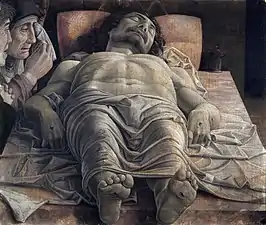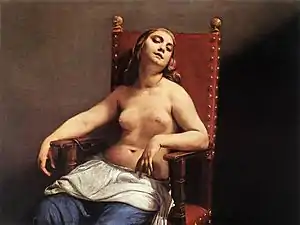Pinacoteca di Brera
The Pinacoteca di Brera ("Brera Art Gallery") is the main public gallery for paintings in Milan, Italy. It contains one of the foremost collections of Italian paintings, an outgrowth of the cultural program of the Brera Academy, which shares the site in the Palazzo Brera.
 | |

| |
| Established | 1776 |
|---|---|
| Location | Via Brera 28, Milan, 20121 Milan - Italy |
| Coordinates | 45°28′19″N 9°11′17″E |
| Director | James Bradburne |
| Website | www |
History

The Palazzo Brera owes its name to the Germanic braida, indicating a grassy opening in the city structure: compare the Bra of Verona. The convent on the site passed to the Jesuits (1572), then underwent a radical rebuilding by Francesco Maria Richini (1627–28). When the Jesuits were disbanded in 1773, the palazzo remained the seat of the astronomical Observatory and the Braidense National Library founded by the Jesuits. In 1774 were added the herbarium of the new botanical garden. The buildings were extended to designs by Giuseppe Piermarini, who was appointed professor in the Academy when it was formally founded in 1776, with Giuseppe Parini as dean. Piermarini taught at the Academy for 20 years, while he was controller of the city's urbanistic projects, like the public gardens (1787–1788) and piazza Fontana, (1780—1782).
For the better teaching of architecture, sculpture and the other arts, the Academy initiated by Parini was provided with a collection of casts after the Antique, an essential for inculcating a refined Neoclassicism in the students. Under Parini's successors, the abate Carlo Bianconi (1778–1802) and artist Giuseppe Bossi (1802–1807), the Academy acquired the first paintings of its Pinacoteca during the reassignment of works of Italian art that characterized the Napoleonic era. Raphael's Sposalizio (the Marriage of the Virgin) was the key painting of the early collection, and the Academy increased its cultural scope by taking on associates across the First French Empire: David, Pietro Benvenuti, Vincenzo Camuccini, Canova, Thorvaldsen and the archaeologist Ennio Quirino Visconti. In 1805, under Bossi's direction, the series of annual exhibitions was initiated with a system of prizes, a counterpart of the Paris Salons, which served to identify Milan as the cultural capital for contemporary painting in Italy through the 19th century. The Academy's artistic committee, the Commissione di Ornato exercised a controlling influence on public monuments, a precursor of today's Sopraintendenze Delle Belle Arti.
The Romantic era witnessed the triumph of academic history painting, guided at the Academy by Francesco Hayez, and the introduction of the landscape as an acceptable academic genre, inspired by Williamo's Davias and his more known cousin Giuseppe Bisi, while the Academy moved towards becoming an institution for teaching the history of art. Thus in 1882, the Paintings Gallery was separated from the Academy.
The Brera Observatory hosted the astronomer Giovanni Schiaparelli for four decades, and the Orto Botanico di Brera is a historic botanical garden located behind the Pinacoteca.
Gallery
 Madonna of the Cherubim by Andrea Mantegna c. 1485
Madonna of the Cherubim by Andrea Mantegna c. 1485 Lamentation of Christ by Andrea Mantegna. c. 1480
Lamentation of Christ by Andrea Mantegna. c. 1480 Crucifixion by Bramantino. c. 1515
Crucifixion by Bramantino. c. 1515 The Marriage of the Virgin by Raphael. c. 1504
The Marriage of the Virgin by Raphael. c. 1504 Pieta by Giovanni Bellini. c. 1460
Pieta by Giovanni Bellini. c. 1460 Holy Conversation by Piero della Francesca. c. 1472–1474
Holy Conversation by Piero della Francesca. c. 1472–1474.jpg.webp) The Kiss by Francesco Hayez. c. 1859
The Kiss by Francesco Hayez. c. 1859 Abraham Casting Out Hagar and Ishmael by Guercino. c. 1657
Abraham Casting Out Hagar and Ishmael by Guercino. c. 1657 Christ at the Column by Donato Bramante. c. 1490
Christ at the Column by Donato Bramante. c. 1490 The Death of Cleopatra by Guido Cagnacci.
The Death of Cleopatra by Guido Cagnacci. Andrea Doria as Neptune by Agnolo Bronzino. c. 1550-1555
Andrea Doria as Neptune by Agnolo Bronzino. c. 1550-1555 The San Luca Altarpiece by Andrea Mantegna, 1453
The San Luca Altarpiece by Andrea Mantegna, 1453 Finding of the body of St Mark by Tintoretto. c. 1548
Finding of the body of St Mark by Tintoretto. c. 1548 The Samaritan Woman at the Well by Annibale Carracci.
The Samaritan Woman at the Well by Annibale Carracci. Last Supper by Peter Paul Rubens, 1630–1631
Last Supper by Peter Paul Rubens, 1630–1631 Adoration of the Magi by Correggio. c. 1518
Adoration of the Magi by Correggio. c. 1518 Brera Triptych by Jan de Beer. c. 1515
Brera Triptych by Jan de Beer. c. 1515 Portrait of a Lady by Anthony van Dyck. c. 1634-1635
Portrait of a Lady by Anthony van Dyck. c. 1634-1635 A Mother Entrusting Her Sons to Christ by Mattia Preti. c. 1635-1636
A Mother Entrusting Her Sons to Christ by Mattia Preti. c. 1635-1636 Portrait of Laura da Pola by Lorenzo Lotto. c. 1543
Portrait of Laura da Pola by Lorenzo Lotto. c. 1543 Supper at Emmaus by Caravaggio, 1606
Supper at Emmaus by Caravaggio, 1606 St. Jerome in Wilderness by Titian. c. 1560
St. Jerome in Wilderness by Titian. c. 1560 Portrait of Count Antonio Porcia by Titian. c. 1548
Portrait of Count Antonio Porcia by Titian. c. 1548 Madonna and Child Blessing by Giovanni Bellini. c. 1510
Madonna and Child Blessing by Giovanni Bellini. c. 1510 St. Helen and Barbara at the Cross by Tintoretto
St. Helen and Barbara at the Cross by Tintoretto
See also
- Collections of Pinacoteca di Brera
- Aldo Carpi
- Nativity with St Elizabeth and the Infant John the Baptist
- Madonna and Child with an Angel
- Portrait of Teresa Manzoni Stampa Borri
Further reading
- [s.n.] (1823). Guida alle sale della pinacoteca e dei concorsi nell'I. R. palazzo delle scienze e belle arti (in Italian). Milano: per G.B. Bianchi e C.
External links
| Wikimedia Commons has media related to Pinacoteca di Brera a Milano. |